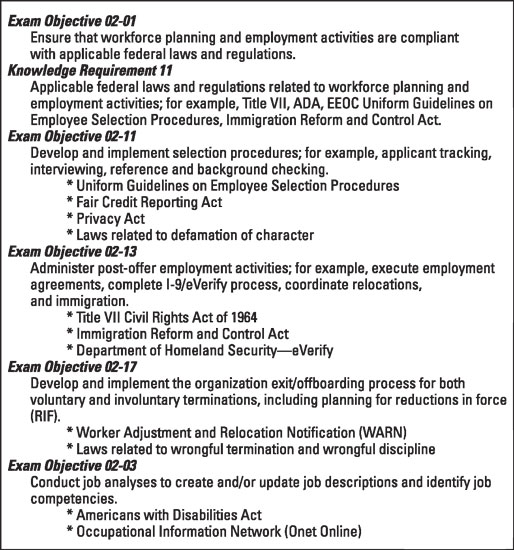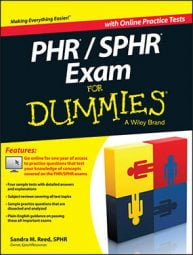One of the biggest oversights of people planning to take the PHR or SPHR exams is that they don't properly utilize the roadmap that is the exam body of knowledge (BOK). This document is straight from the horse's mouth — the Human Resource Certification Institute (HRCI).
Although many excellent preparation resources are on the market that have successfully prepared exam takers for decades, the exam BOK should be the foundation of all of your efforts. Here are organizational tools and textbook-alternative resources you can create using the exam BOK as your guide. Doing so ensures that you have a well-balanced approach to tackling the exams that goes beyond simply reading a textbook.
Being organized and planning
Having a plan and then knowing what you need to do with the right materials can be the difference between streamlined studying that produces results or disorganized chaos that is stressful for all involved. The following items share a common thread. They're all tools that you can use to get ready to study:
Binders: For exam prep, you need one place to put all of the detritus that will collect during the preparation process. Try a binder with seven dividers — one section for core knowledge and the rest for the functional areas. Store fact sheets, notes, and other data related to the exam objectives. Follow this important process before you even first pick up your study guide:
Print out the exam objectives from HRCI.
Divide it out by exam functional area.
Insert the documents under the proper functional area.
Refer to these objectives every time you crack open a book or log in to study. In fact, attempt to match up what you read to the relevant exam objective or knowledge requirement to ensure that you're properly aligning your knowledge with what may be presented on the test.
Index cards: Index cards are useful to breaking down complex pieces of information into manageable concepts. Consider color-coding your index cards with highlighters and using single colors for key exam concepts. Assign one color per exam objective or be more selective and use certain colors for difficult topics.
Recordings: Reading or speaking aloud into a recording device is a valuable technique that allows you to study the same material in different ways, first by reading it aloud and then by listening to it later.
Peppermint gum: Peppermint has been shown to be a gentle brain stimulant that increases both recall and memory. Peppermint gum has an added benefit for tactile learners. Chewing gum while studying is a physical activity and can help your brain create deep grooves for information recall.
Using outlines
An outline is a great way to condition your mind to build frameworks out of complex information. Examples of complex information on these exams include academic theories or processes that have multiple threads that must be followed to successful completion. An outline is a tool that forces you to extract the main point of a theory or process, and then fill in the blanks as you further review the data.
Try to write your outline from the end to the beginning of a concept rather than from beginning to end. Starting with the end will at first be confusing, but as you work your way up, your mind will be required to pay attention to the items that naturally help you fill in the blanks and make the necessary connections for understanding.
The figure is an example of an outline for Workforce Planning and Employment. Create one and go one step further and begin to research the sub-bullets by completing the information as it relates to the specific exam objective. Consider using the who, what, where, when, why, and how approach when researching the laws as they relate to the objective.

Going online
The Internet has tons of resources that you can tap into to drill further into the exam objectives. When you go online to gather more information about a specific topic, stay extremely focused. When creating your study plan, pick two or three exam objectives per functional area, and then plan to use online videos to support your studying.
HRCI has a list of study resources that you should utilize in your study plan. The site includes a list of books and management authors. Click on the tab titled "Exam Preparation" then "How do you Study?" to find the resources.
Interviewing subject matter experts
More than likely, you have contacts in the industry who would be helpful in breaking down information related to the exams. You may even have a few at your place of employment. Taking time to ask these HR professionals about their expertise and about specific scenarios can help you study for the exam.
Here are five sample questions related to these exam objectives:
What kind of information needs to be collected and tracked for compliant payroll processing?
What other payroll-related processes can be outsourced, and why should an employer choose to do so?
What types of employee self-service technologies are you seeing emerge, and how can they be adapted?
What are some common misconceptions about payroll outsourcing?
What forms of training do you use for your employees, and would you recommend it to me as I prepare for this exam?
Presenting unfamiliar exam objectives
One technique to master difficult concepts is teach-to-learn. You more than likely have training responsibilities on your job. With the variety of exam objectives in all functions of HR, there is probably a topic in which your employees could use a training class. Pick an item that you aren't extremely familiar with and create a training presentation that forces you to go into research mode. Some examples include preventing harassment, coaching employees, or increasing production through employee motivation techniques.
Comparing HR best practices to your work experience
Take some time to review the exam objectives for each functional area and compare them to how they apply to your workplace. You may not be surprised to note that you do things a bit differently where you work, which is because these are HR practices that HRCI — through field studies and interviews with subject matter experts (SMEs) — has identified as best in the field. Knowing where your workplace veers off of the exam objectives will raise your awareness on where you may struggle on your exam. By doing this exercise, you can identify that you need to do some extra legwork to understand why the strategic planning process is a valuable tool for employers.
If you work in the type of environment where it's acceptable, take this strategy a step further and educate your bosses on why they should be doing things a different way. Practice building a business case (data-driven justification for a work activity) and use it to sway your employer to the best business practice of the exam objective(s).
Discerning action objectives from knowledge objectives
Closely look at each exam objective to spot action words such as design, implement, and measure, which is in contrast to the knowledge components that use phrasing such as techniques, methods, and types. Understanding what the exam objectives are asking of you will define the how, as in how you need to study the concepts and the what, as in what should be studied (techniques, methods, types).
Establishing both context and form is important. Understanding that you need to know how to develop (action) and test (action) business continuity plans (exam objective) is different from the knowledge of data storage and back up.
Work to spot these links and differentiate between what is actionable versus knowledge based. Doing so can help you interpret what the exam items are asking of you when you face them on the test.
Space practicing for success
Spaced practice is the studying of material over a longer period of time, which is the opposite of massed practice, which is more commonly referred to as cramming. Giving yourself 12 or 14 weeks to study allows your brain to absorb not only pieces of information, but also how the information applies as a whole. On a smaller scale, consider using spaced practice on a weekly basis.
Knowing where to focus when studying labor laws
These exams do have a few studying techniques that work better than others, particularly in the area of going over the labor laws. Concentrate on the following when studying labor laws:
Labor law names
Dates when laws passed
The numbers: You need to know the number of employee threshold that triggers labor law compliance, and be sure to review the number of months that activates certain activities, such as the Consolidate Omnibus Budget Reconciliation Act (COBRA) coverage and union elections.

